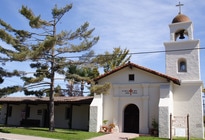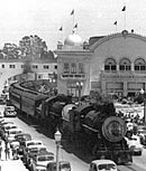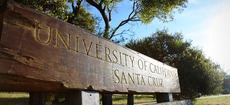A Journey through Time

Before Santa Cruz County was home to the 200,000 plus residents who live here today, it was home to the Awaswa speaking Ohlone Native Americans. The Ohlones migrated to the area more than 8000 years ago from the Sierra Nevadas. They settled in small villages that were scattered along the Monterey Bay and San Francisco Bay region. They based their livelihood on abundant marine resources such as salmon and shellfish. There were said to be no more than a thousand of them, with eight different language speaking tribes under the umbrella name Ohlone.
In 1769, the Spanish explorer, Don Gaspar del Portal, discovered the land area now known as the city of Santa Cruz. He named the long flowing river San Lorenzo in honor of Saint Lawrence and named the rolling hills Santa Cruz, "Holy Cross."
In 1791, Father Fermin de Lasuen, continuing Junipero Serra's work, established the mission of Santa Cruz, "La Mision de la Exaltacion de la Santa Cruz." Santa Cruz was the 12th mission founded in California. In the area now known as the East Side of Santa Cruz, Villa de Branciforte was established, it being one of three Spanish civil settlements in California, the other two being San Jose and Los Angeles. Villa de Branciforte later lost its civic status and merged with the Mission Santa Cruz Community.
By the 1820's, Mexico had control of the area, and for the next twenty years, people began to arrive in large amounts. In 1850, California became a state and Santa Cruz County became the twenty-seventh original county. Santa Cruz was then incorporated as a town in 1866 under the laws of the State of California.
In 1769, the Spanish explorer, Don Gaspar del Portal, discovered the land area now known as the city of Santa Cruz. He named the long flowing river San Lorenzo in honor of Saint Lawrence and named the rolling hills Santa Cruz, "Holy Cross."
In 1791, Father Fermin de Lasuen, continuing Junipero Serra's work, established the mission of Santa Cruz, "La Mision de la Exaltacion de la Santa Cruz." Santa Cruz was the 12th mission founded in California. In the area now known as the East Side of Santa Cruz, Villa de Branciforte was established, it being one of three Spanish civil settlements in California, the other two being San Jose and Los Angeles. Villa de Branciforte later lost its civic status and merged with the Mission Santa Cruz Community.
By the 1820's, Mexico had control of the area, and for the next twenty years, people began to arrive in large amounts. In 1850, California became a state and Santa Cruz County became the twenty-seventh original county. Santa Cruz was then incorporated as a town in 1866 under the laws of the State of California.

With the creation of the railroad came the tourism industry and much more. Fred Swanton built the Beach Boardwalk that we see today in 1907 with the Looff Carousel being installed in 1911 and the Giant Dipper in 1924.
With the only way to enter and leave Santa Cruz was by the railroad, the city was desperate for another means of transportation. In 1919, the first paved road over the summit was built, the Glenwood Highway. This highway passed through the small town of Glenwood. Then in the 1940's, Highway 17 was built, linking Santa Cruz by highway with the rest of northern California. Highway 17 made the railroads unprofitable and Glenwood Highway unfavorable.
In 1956, President Eisenhower established the Sister City Program to promote understanding and strengthen international ties. These affiliations provide the opportunity to learn about other cultures, build friendships and foster international understanding. With Italian and Japanese culture being so influential in Santa Cruz's history, with the Stagnaro Bros Fish Market and Japanese Farmers, it is no wonder that Shingu, Japan and Sestri Levante, Italy are Santa Cruz's sister cities along with Jinotepe, Nicaragua, Puerto La Cruz, Venezuela, and Alushta, Ukraine.
With the only way to enter and leave Santa Cruz was by the railroad, the city was desperate for another means of transportation. In 1919, the first paved road over the summit was built, the Glenwood Highway. This highway passed through the small town of Glenwood. Then in the 1940's, Highway 17 was built, linking Santa Cruz by highway with the rest of northern California. Highway 17 made the railroads unprofitable and Glenwood Highway unfavorable.
In 1956, President Eisenhower established the Sister City Program to promote understanding and strengthen international ties. These affiliations provide the opportunity to learn about other cultures, build friendships and foster international understanding. With Italian and Japanese culture being so influential in Santa Cruz's history, with the Stagnaro Bros Fish Market and Japanese Farmers, it is no wonder that Shingu, Japan and Sestri Levante, Italy are Santa Cruz's sister cities along with Jinotepe, Nicaragua, Puerto La Cruz, Venezuela, and Alushta, Ukraine.

With the tourism boom declining in the late 1950's, the announcement that the University of California's Board of Regents wanted to build three new campuses, Santa Cruz knew that campus would grow the city. The local growth coalition decided that the old Henry Cowell limestone and ranch lands, coupled with a few hundred acres of undeveloped land would make for an attractive location for the new campus. Santa Cruz fought and fought for the new campus and in 1960, the decision was finalized, Santa Cruz was going to become a college town. UC Santa Cruz was then opened in September 1965.
All of these historical events, along with many others, make Santa Cruz what it is today: a vibrant, progressive and loved city.
All of these historical events, along with many others, make Santa Cruz what it is today: a vibrant, progressive and loved city.
